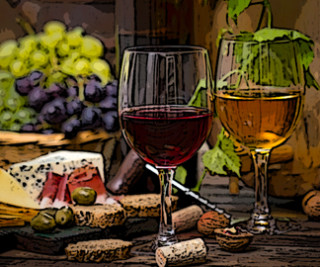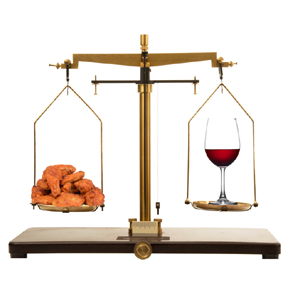The WineSnark Academy for Sensory Testing, Evaluation & Debauchery (W.A.S.T.E.D.) On Food & Wine Pairing Principles.
Chapter Nine, Parts Two & Three.
 Shortly after WineSnark began its detailed research into taste perception it became apparent that an undertaking of this magnitude required a research team of dedicated, compassionate wine professionals, or as they’re known in the trade, drunks.
Shortly after WineSnark began its detailed research into taste perception it became apparent that an undertaking of this magnitude required a research team of dedicated, compassionate wine professionals, or as they’re known in the trade, drunks.
And so was born the WineSnark Academy for Sensory Testing, Evaluation and Debauchery (W.A.S.T.E.D.). We WASTED professionals do not take our research sitting down, as getting back up is often difficult, and because thousands of grapes have given their lives to further our understanding of human physiology, biochemistry, sensory perception and stuff.
After years of research the academy came to the groundbreaking conclusion that when pairing wine with food, your wine selection should complement your dinner. Who knew? We’re not saying that when wine is introduced to food it should declare, “You look marvelous in those carbs and I love what you’ve done with your pear.” We simply mean that for wine and food to play nicely with each other, their textures and flavors must interact in a complementary way, you know like tea complements crumpets or candy complements diabetes.
The complementary interaction between food and wine is similar to the subtle collaboration between ingredients in a recipe. When seasoning a delicate white fish you may discover a touch of thyme adds a welcome layer of flavor but fresh ground pepper overpowers the fish. Now imagine the ingredient you’re adding is wine. A grassy, herbaceous Sauvignon Blanc will interact with the fish much as thyme does, while a dark, slightly bitter Cabernet Sauvignon is more analogous to black pepper.
Okay, that was an easy one. So what happens when you pair a high alcohol Zinfandel with stuffed habaneros, or when a lemon tart meets a Clos de Tart? The principles of food and wine pairing we’ve discovered are based on the interaction of our five basic tastes – sweet, sour, salt, bitter, and umami – plus piquance and texture. Like a Clint Eastwood spaghetti western, the rapport of these components can change your dining experience into the good, the bad or the ugly.
At the very least, the guidelines outlined in the next series of blog posts will help you avoid the bad and the ugly experiences. These pairings occur when mismatched components magnify certain tastes, changing the delicate balance and rendering your wine or food overly sweet, sour, bitter, or piquant. Good matches bring out the best in food and wine by suppressing unpleasant flavors while enhancing pleasing characteristics. This creates an enjoyable balance between food and wine, and may even achieve greatness when all the elements combine to produce new flavors in an eye-popping synergistic reaction.
When you experience this synergy you have found food and wine pairing nirvana, at least until the check arrives. Open your mind and your mouth to these guidelines and you may open the door to new and exciting synergies when dining.
Weight for the New Rules
 As a rule of thumb I generally thumb my nose at rules, but when it comes to pairing food and wine I invariably start by matching the weight of the wine to the weight of the meal. Both food and wine can run the gamut from light-bodied (delicate) to full-bodied (rich), and a drastic mismatch can wreak havoc for one or the other. For example, you wouldn’t pair a delicate white fish with a heavy Syrah would you? You may be thinking, “Hey Winestein, I already know The Rule – white wine with fish/red wine with meat,” but keep in mind, The Rule refers to color rather than weight. The rule-makers should have proclaimed light-bodied wines with light-bodied food, full-bodied wines with full-bodied food.
As a rule of thumb I generally thumb my nose at rules, but when it comes to pairing food and wine I invariably start by matching the weight of the wine to the weight of the meal. Both food and wine can run the gamut from light-bodied (delicate) to full-bodied (rich), and a drastic mismatch can wreak havoc for one or the other. For example, you wouldn’t pair a delicate white fish with a heavy Syrah would you? You may be thinking, “Hey Winestein, I already know The Rule – white wine with fish/red wine with meat,” but keep in mind, The Rule refers to color rather than weight. The rule-makers should have proclaimed light-bodied wines with light-bodied food, full-bodied wines with full-bodied food.
When The Rule was conceived white wines were predominately light-bodied but today it’s not unusual to find a $10 Chardonnay that’s as full-bodied as some red wines. Due to a movement towards more balanced wines many reds are now produced in a lighter style, and thanks to the movie Sideways, light-bodied Pinot Noir is the rage at fashionable dinner tables, while medium-bodied Merlot has become the metaphorical equivalent of a slurpee at a Jersey Turnpike truck-stop.
Now, more than ever, there exists a vast middle ground where wines of different color but similar weight overlap. These similarly weighted whites, reds, and rosés offer a treasure trove of interchangeable pairing possibilities. Perhaps our new rule should be further amended to read, light-bodied wines with light-bodied food, medium-bodied wine with medium-bodied food, full-bodied wines with full-bodied food, and while we’re at it we should probably add, only serve beer with chili.
Do you remember the post about the woman whose date took her to a milk tasting? She learned about the weight of wine by comparing it to skim, 2% or whole milk, and that knowledge helps her pick the right wine for dinner with her new boyfriend.
When contemplating a food and wine pairing, ask yourself, “What is the weight of my meal?” A delicate white fish like flounder is certainly lighter than swordfish or tuna, but how does chicken or turkey stack up against their feathered brethren, goose, duck and pheasant? And then there’s pork, veal and beef which all tip the scales more than fish or fowl. Once you’ve determined the richness of your meal, choose a wine of similar weight, but not necessarily similar color.
If your wine choice is notably lighter than your meal, it will seem insufficient and overmatched. At consumer wine tasting events I recommend tasters try light wines before full for this reason. If you choose a wine that’s heavier than your dinner, it may overpower the meal but it takes a pretty wimpy meal or a wine on steroids to significantly strip food of its flavor so if you’re not sure which wine to choose, err on the side of the richer wine. Just keep in mind; you could end up with a fowl pairing if the hen is mightier than the poured.






















